| Date: 1944 Feb 10/10 | A/C Type: B-17G Fortress | SN: 42-31218 | Code: FC-E | A/C Nickname: ETO-Itis | 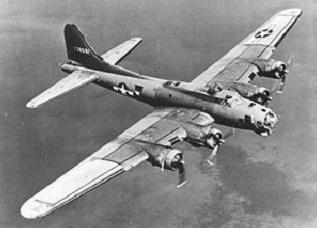 |
|||||
| File: 423 | Airforce: USAAF | Sqn/Unit: 390 BG - 571 BS | Mission/Raid: Brunswick (Braunschweig) | |||||||
| 1 | Pilot | 2Lt. John G. Burke POW direct | 9 | RWG | S/Sgt. Earl S. Lambert evd | |||||
| 2 | Co-pilot | 2Lt. Charles J. Hadfield evd | 10 | TG | S/Sgt. Jerome A. Vilk POW direct | |||||
| 3 | Nav. | 2Lt. Howard E. Richardson evd | 11 | |||||||
| 4 | B | 2Lt. Andrea Montello wounded, POW direct | 12 | |||||||
| 5 | E | S/Sgt. John F. Graney evd | 13 | |||||||
| 6 | RO | S/Sgt. James A. Harnish KIA in air. | 14 | |||||||
| 7 | BTG | S/Sgt. Angelo Gambino evd | 15 | |||||||
| 8 | LWG | S/Sgt. Woodrow W. Tarleton evd | 16 | |||||||
Over target hit by Flak and lost power in an engine. Dropped slowly out of formation on return, last seen at Lingen at Dutch-German border at 13:00h. As lone straggler in eastern Netherlands attacked by fighters that killed Sgt. Harnish. Severe fire in wing forced the other nine crew to bail out. Aircraft crashed and ruined a farm north of Blokzijl at Baarlo. Six men could evade deep into Belgium. |
||||||||||
MACR: "15 minutes before bail-out, Sgt. Harnish (Radio Operator & top turret gunner) reported FW-190's coming in from above. He fired a long burst. Then everything was quiet for a few minutes, after that we were hit from all directions, we didn't have time to check all positions. Harnish probably hit by 20mm, as they were hitting around the waist and radio room. The aircraft was on fire by the gas tank so we jumped in a hurry".
Sgt. Graney: "We were jumped by 10 enemy fighters. Harnish's radio room door stayed closed when we jumped. No one closes the door when bailing out (so he had to be still inside). I wanted to go back to see if he were OK. Burke said to take care of it". Waist gunner Sgt. Lambert: "Two engines out, stabilizers & wings damaged, no 2 engine on fire. Bail out at 20.000 ft (6000m).
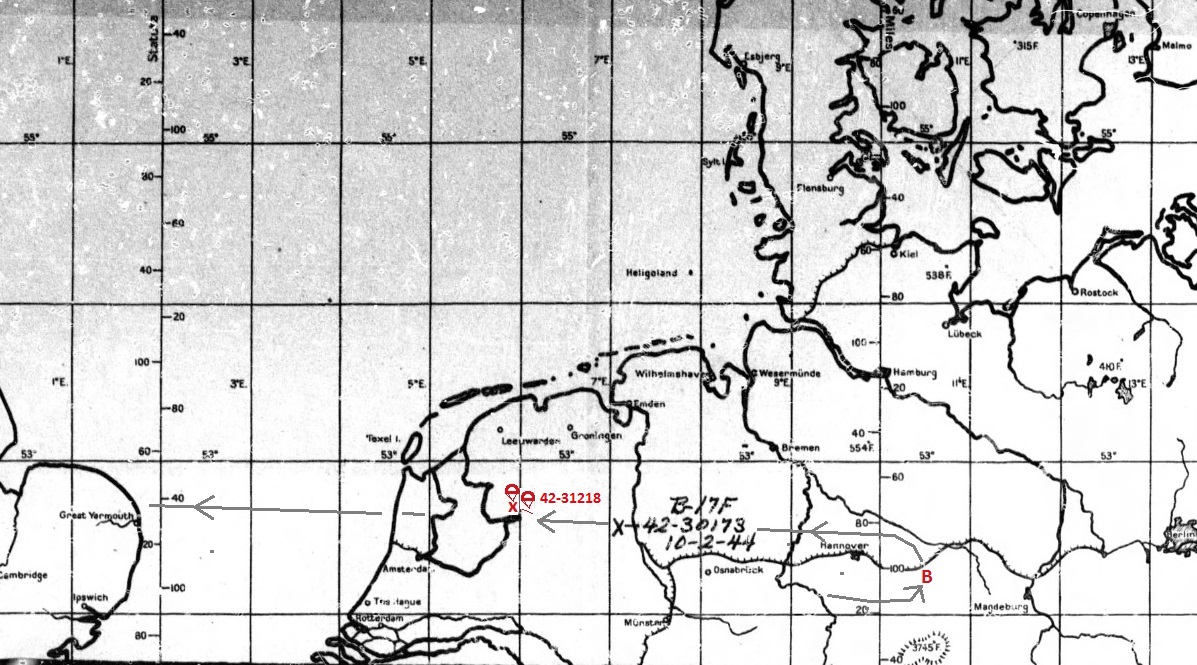
After the crew bailed out (pilot Burke last), the empty bomber stayed in level fight and kept descending. It just over passed Blokzijl and bounced and veered up over a meadow at Baarlo. A burning wing and engines broke-off. All rolled forward at high speed into direction of two farms, that of farmer Benthem and farmer Lok, scooping-up and smashing cows underway. A young boy stood paralyzed in the yard observing the nearing havoc. His father ran towards him and with the kid in his arms, the farmer dove behind the brick wall of the barn. Seconds later the barn was smashed. The roof collapsed, bricks, mud and burning debris covered them. When most noise was gone, the farmer looked at his son under him, covered in thick warm blood. They were unharmed, a mutilated cow was hanging over them on a piece of wall.
The charred body of an airman was found (Sgt. Harnish). Two days later he was buried (grave 3), Cemetery Baarlo. File: http://www.zzairwar.nl/dossiers/921.html
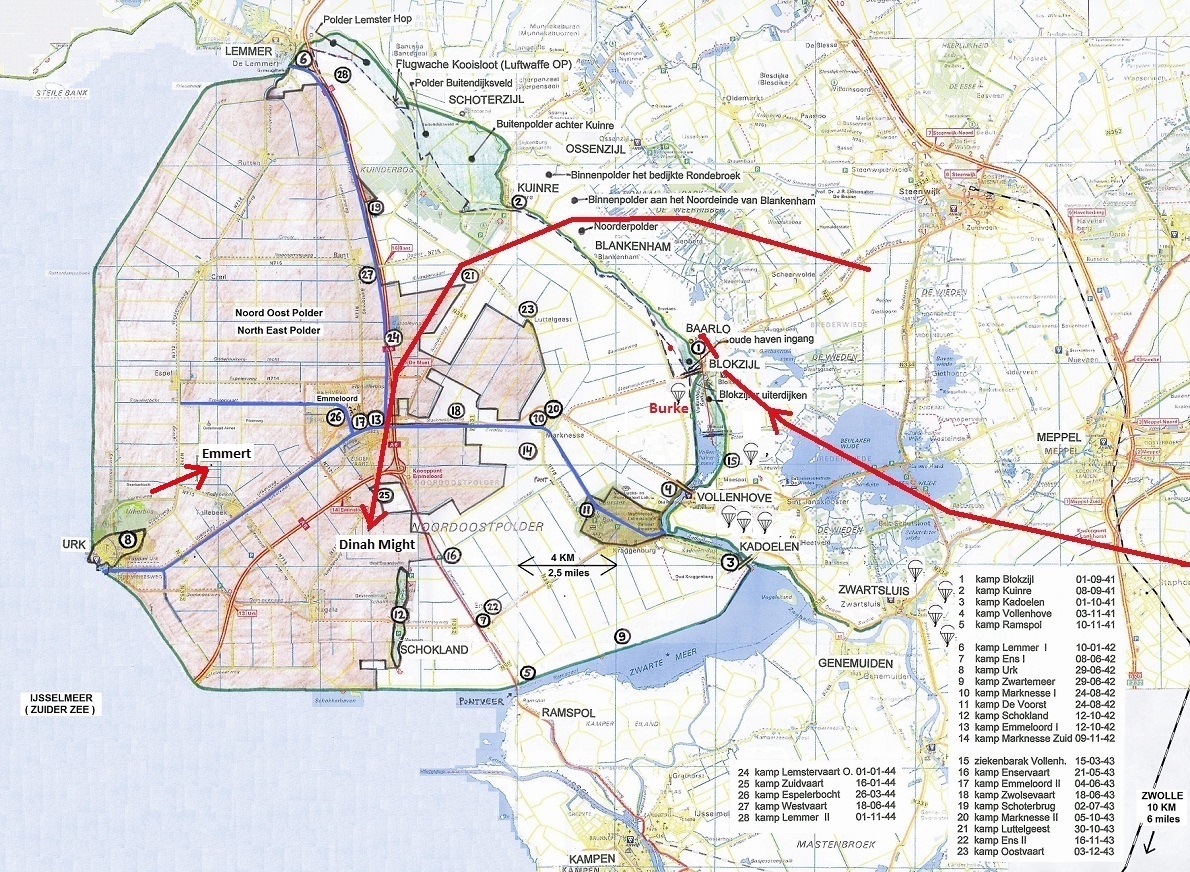
The crew arrived on the ground in this order; south at Zwartsluis: Graney, Tarleton, Gambino and Lambert. They were assembled after two days in nearby Meppel at resistance leader and famous pilot-helper Peter van den Hurk (Medal of Freedom Gold). South-east of Vollenhove landed Montello, Vilk (both POW) and Richardson. Northeast of Vollenhove: Hadfield. He and Lt. Richardson were helped and came in first hiding at the Kingma family in Vollenhove. As last and landed just inside the Polder was pilot Burke.
The POW: Pilot 2Lt. Burke, bombardier 2Lt. Andrea Montello (NMI) and S/Sgt. Jerome Vilk (tail gunner). Burke jumped last and landed just in the polder, close and in full view of the German post on the old dyke at Blokzijl (POW). Lt. Andrea Montello was hit in the air in the leg by a .31 round (7,92mm). He was brought in the Vollenhove police station and became POW. S/Sgt. Jerome A. Vilk landed in a tree and got stuck, POW.
The two officers, co-pilot 2Lt. Hadfield and navigator 2Lt. Richardson, went from Kingma first in northern direction, towards Drachten in Friesland (at Zylstra). Months later both were guided south towards the Belgian border and stayed in Kaatsheuvel (at Simon de Cock). Only just crossed into west-Belgium, they were arrested in Antwerp in August 1944 (POW).
Peter van den Hurk used his reliable guide Ms. Joke Folmer (Medal of Freedom with Gold Palm) to escort the sergeants Graney, Tarleton, Gambino and Lambert to the south by train. Sgt. Lambert says in the MACR "five of us were together". This is correct; the 5th man was 2Lt. John Lyons of the B-17 42-37950 'Dinah Migth', which came down nearby also on the 10th. There is a photo of Sgt. Graney and Gambino with Lyons in hiding with the Teuwen family in Roermond. All came in Maastricht in the care of pilot helper Jacques Vrij. They crossed the Maas river at night in a rowing boat. All reached the city Luik (Liège) and stayed in an old factory. In this factory they were split-up. Sgt. Earl lambert stayed undergound in Liège and was liberated by American troops September 8, 1944. On the 10th he was back in England.
Sgt. Graney, Gambino and and Tarleton saw each other in hiding in Brussels, the start of the famous pilot-escape lines. However, the invasion in Normandy June 6th made further movement south difficult. Team Graney and Gambino could travel on to Charleroi, but because of a traitor working for the German Sicherheitsdienst, they were arrested there on 26 July 1944 (POW). Sgt. Tarleton had to stay in Brussels for three months. Eventually he was moved south past Charleroi to secret underground camps in the woods near Acremont and Porcheresse, not far from Bastogne in the Ardennes. He and 50 other Allied soldiers and airmen in hiding there were liberated by US troops begin September 1944. On September 11, he was back in the UK.
Boek de Duikhoek (Book "the Hide-Out Corner") 1947
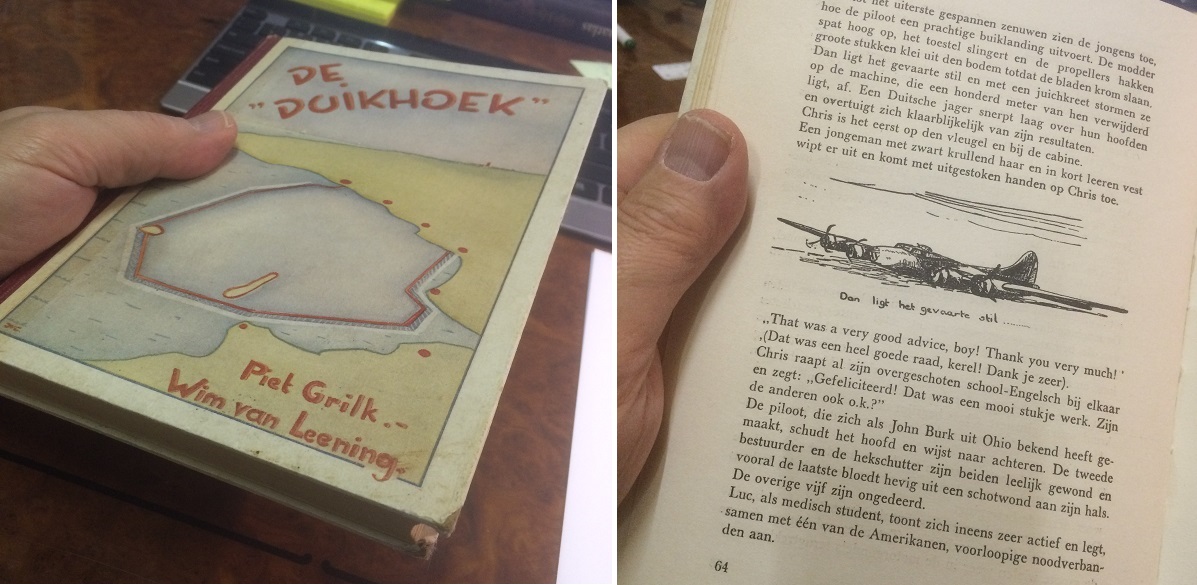
Already two years after the war in 1947, novelle 'de Duikhoek' came out. Written by Wim van Leening and Piet Grilk, an alias of Pieter Terpstra of Leeuwarden, later a well known Dutch writer. In WW2 both choose to work as diggers, cultivating the new Northeast Polder. This was a better alternative than mandatory slave labor in Nazi-Germany that was ordered for every Dutchman. They dug by hand draining canals through the reed plains with a team of eight men. In the book is described an encounter with an American crew of a B-17, that belly landed next to them. Post war, the intention of the novelle was not to be a 100% accurate history book, but depicts the general life, the hear-say and experiences of Piet and Wim in those days. In fact, the event with their B-17 is a combination of three B-17 stories that actually happened there, but were mixed up and entwined already in 1943/1944. The story combines parts of events with B-17G 42-37751 Emmert (08 October 1943), B-17G 42-37950 Lt. Sharpless 'Dinah Might' (10 Feb. 1944) and B-17G 42-31218 Lt. Burke (10 Feb. 1944). The story on book page 63, 64 and 65:
"On the bike, it takes us 15 minutes to go from Lemmer to camp Lemmer and its management barack. From there we pedal along the dike in direction of Urk until we reach the green wagon of foreman Vos [1]. The excavation crews have begun digging at Lemmer, now they are somewhere halfway, not far from the dike. To the right is a vast sea of yellow flowers. It is warm in the summer of 1943 [2]. The lunch wagon is on the dike. We work until 18:00h, but are back home in Lemmer at 18:15h. These are our first working days. Most other diggers are Frisians from the Lemmer area. We know the Northeast Polder only on what we can see from the dike. Later an experienced digger proposes to the foreman to set-up a novice digger crew. A bank director's son from The Haque is put in charge, his name is Koen Evertse. 2nd is Gerard, son of milkman from Amsterdam. The others are Peter, a former police inspector, Chris, former military pilot, student Luc, Amsterdam student Paul Rengers and student Joop Vriesma who is the son of the doctor in Lemmer. After a few days digging, Paul and Joop hardly have the strength to pedal back to Lemmer. The others sleep in camp Lemmer. It is very hot in the Polder. After a few weeks we have past the blister-stage on our hands. Jewish Sam from Amsterdam joines the team and also Koos, a demoted tractor driver".
"The terrain where we work now is deep in the wilderness. Paul and Joop have to bike 45 minutes from Lemmer to get there. From camp Lemmer it is a an hour walking. We are on the end of civilization. Bomber streams with fighters come over us and go in direction of Germany. After 2 hours and 15 minutes they return. Suddenly a low flying B-17 approaches us, one propeller stands still, an other smokes and coughs. He passes over us, two parachutes are in the sky, blinking in the sun [3]. De machine turns. The pilot is avoiding the land where we dug the canals. He is turning nose in the wind and goes for a belly landing on the wild, uncultivated land."
"One of our team of diggers, Chris the ex-pilot, is trying to explain with wild arm motions to the B-17 pilot that he has to retract his landing gear. The pilot sees it, and retracts! And carries out an excellent belly landing [4]. A German fighter passes low over our heads, apparently convincing himself of his results. The diggers ran towards the machine that lays 100 meter further. Chris climbs as first on the wing and is near the cockpit. A young man with black curly hair and short leather vest comes out en walks to Chris ready to shake both hands. "That was a very good advice, boy! Thank you very much!" Chris uses all school-English he masters and says "Congratulations! That was a nice piece of work. Are the others also OK?" The pilot who introduced himself as John Burk of Ohio [5], shakes his head and points to the rear. The co-pilot and tail gunner are both badly wounded and especially the latter is bleeding severely from a bullet wound in the neck [6] The other five are unharmed".
"Luc, medical student as he is, is suddenly very active and dresses emergency bandages together with one of the Americans. Chris views into the cockpit with its modern equipment. Meanwhile other diggers from all directions rush to the scene. De students explains to their colleagues all they know: mission was Brunswick [7], first pilot is a volunteer-student from Ohio. Chris has received a thermos flask, others get gloves [8] and such. A dust cloud in the distance gets Gerard attention "There come our protectors", he says. Moments later German soldiers enter the spot, coming through the tall weeds. The crew is disarmed. Aircraft is now guarded. Shortly after, a doctor from Vollenhove arrives and helps the wounded [9]. They are moved towards the small Polder infirmary. Some Germans accompany the group. Everybody goes back to work. A half hour later a German soldier rushes towards them, asking if they have seen the two parachutists at large. "Well', is the answer, "the Polder is 48.000 hectares large, maybe you run into them even today". A wheelbarrow must be delivered back in Schoterburg. That is an hour and a half walk. Then wheat has to be mowed at farmer Oosteringa. Near there stand the old harbor entrances of Kuinre and Blokzijl".
Article below, John G. Burke
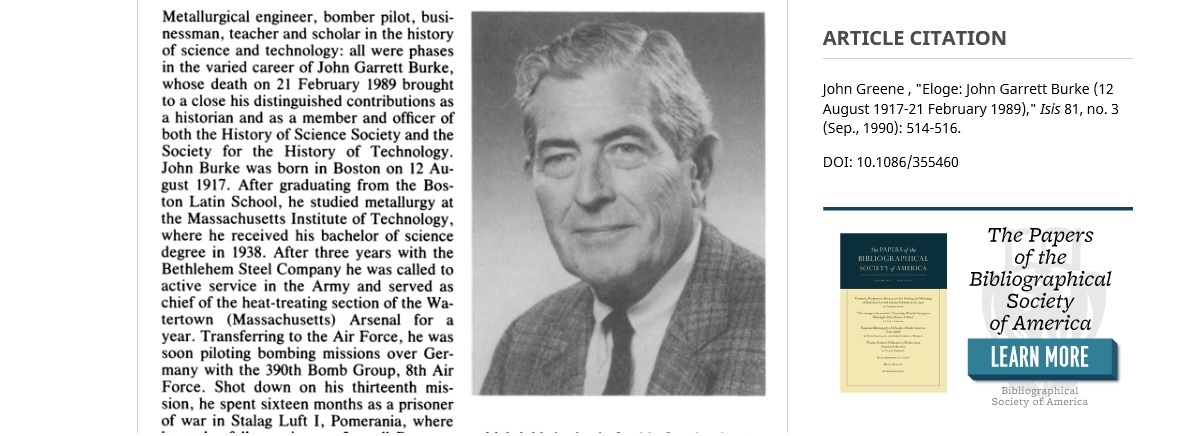
1. Foreman Hielke Vos. He played an important role in helping airmen of Lt. Emmert's crew to Urk, 8 October 1943.
2. Lt. Emmert's B-17 came down end of summer 1943. Lt. Sharpless and Burke came down in freezing temperatures, winter, 10 February 1944.
3. Two parachutes only can be seen of Lt. Sharpless and Burke's aircraft. Lt. Emmert had all crew aboard in the belly landing.
4. Lt. Emmert and Sharpless belly landed. Burke's aircraft crashed in flames on a farm just outside the polder.
5. The writer knew the name of John Burke. Apparently Lt. Burke had the chance to talk to people before he was arrested.
6. Pilot Lt. Emmert himself was heavily wounded by a bullet through the stomach. His co-pilot Lt. Robert W. Fortnam did the belly landing and walked out the plane.
In the aircraft lay bombardier Walt Fox with a mutilated leg, shot by a 20mm round. Tailgunner Sgt. Howard L. Newton was strafed by a bullet in the neck.
The Dinah Might had no co-pilot in the cockpit at moment of belly landing. Engineer S/Sgt. Lawrence Moses had 20mm fragment through knee.
7. Lt. Sharpless and Burke had mission Brunswick. Lt. Emmert had mission Bremen.
8. The under gloves where handed to Joh. Gerssen by Lt. Emmert's crew. He used the gloves drumming in drumband 'Valerius' in Urk.
9. Doctor was J. Andriessen from Urk.
Map of escape route crew:
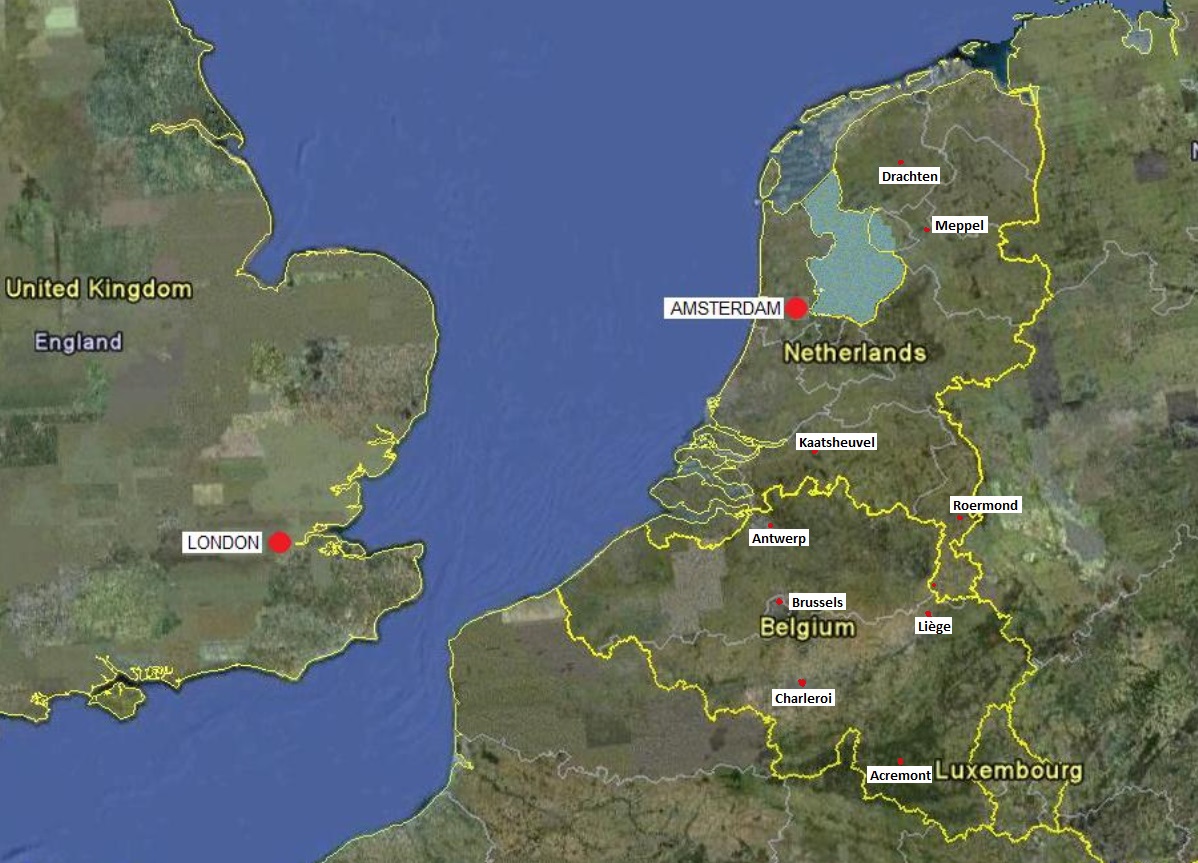
© ZZairwar (Zuyder Zee Air War)
.